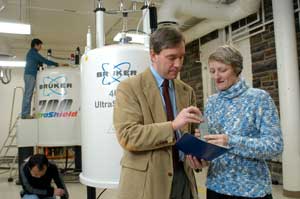 |
| Josef Zwanziger |
Josef Zwanziger is in the business of investigating "stuff" and wondering why "things" are the way they are
To be exact, the "stuff" and "things" that interest Zwanziger are materials, like optical glass and the guts of lithium-ion batteries. They«re materials that we rely on every day when we pick up the phone or turn on a laptop computer. As Canada Research Chair in Nuclear Magnetic Resonance Study of Materials, and Director of the Atlantic Region Magnetic Resonance Centre at Dalhousie, he«s finding ways to make these materials better by studying and characterizing them, atom by atom.
Materials research is one of Dalhousie«s research strengths, and Zwanziger is adding greatly to it using the largest nuclear magnetic resonance (NMR) spectrometer devoted to materials research in Canada. NMR spectroscopy is a unique method of examining the structure of a given material at the atomic level. "Materials" can be almost any substance, but in this case, he focuses on two in particular.
"We have a really active effort making new polymer-based materials for lithium-ion batteries," he says, referring to the type of batteries commonly used in laptop computers and cell phones. His research is targeted at battery electrolytes, or the substance within the battery that creates electric energy. Traditionally, electrolytes are composed of metals and liquids such as acid, making them heavy and potentially dangerous to people and the environment should the contents leak.
Zwanziger and his research assistants are looking at the structure and properties of different kinds of electrolytes, like plastic and liquid combinations. The goal is to develop an electrolyte that that packs enough punch for the most power-hungry electronic gadgets or possibly electric-powered vehicles, while remaining lightweight and safe, even if the battery breaks open.
His other research area is glass, particularly glass fibre used in communications networks. By examining the bonds between glass atoms and different additives, he«s determining which compositions are most resilient to pressure and stress. "A glass that«s sensitive to pressure could potentially disrupt global communications, because it can«t transmit signals properly," he says. "This research will help us choose the kind and amount of additives we can use in glass to make it resistant to pressure, but still have good optical performance for communications."
Coming from Indiana University in 2003, Zwanziger continues his collaboration with Corning Inc. at Dalhousie. In addition to his research associate and wife Ulli, an NMR methodology expert, Zwanziger works closely with two postdoctoral fellows and an editorial assistant.
Four new Canada Research Chairs at Dalhousie have been announced, with a funding commitment from the Chairs Program of $3.8 million. The research of Aaron Newman, Christopher Richardson, David Waisman, and James Fawcett will address topics such as how the brain is affected by deafness, repair of nervous systems, developing vaccines to prevent viral disease, and the study of cancerous tumour and how they are spread. Look for more profiles of Canada Research Chairs in Dalhousie News in the coming weeks.
